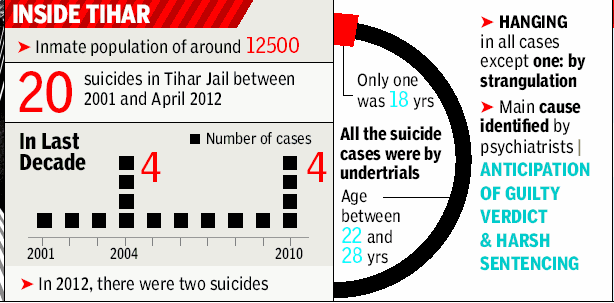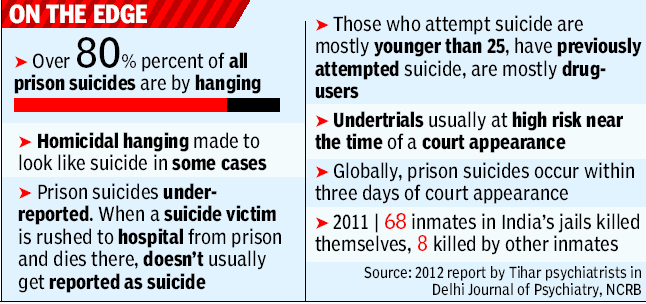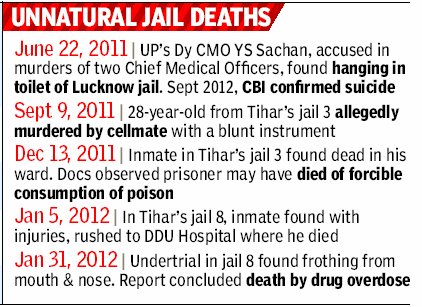Jails/ Prisons: India
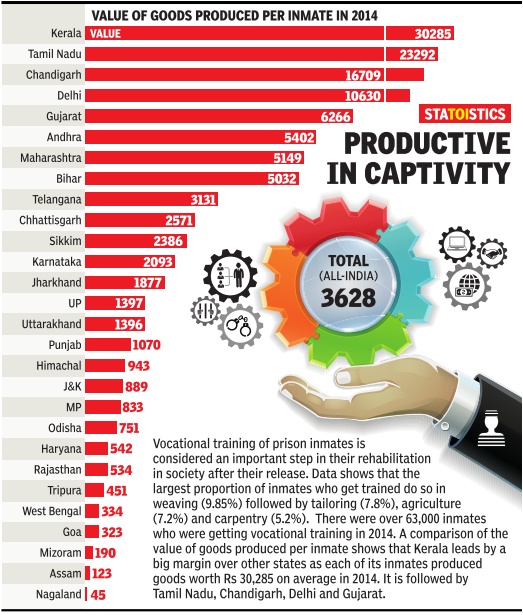


Contents |
Overcrowding
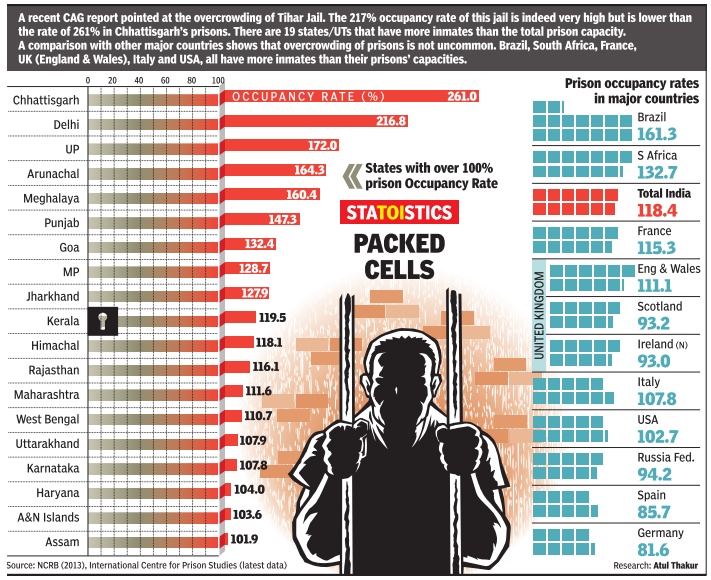
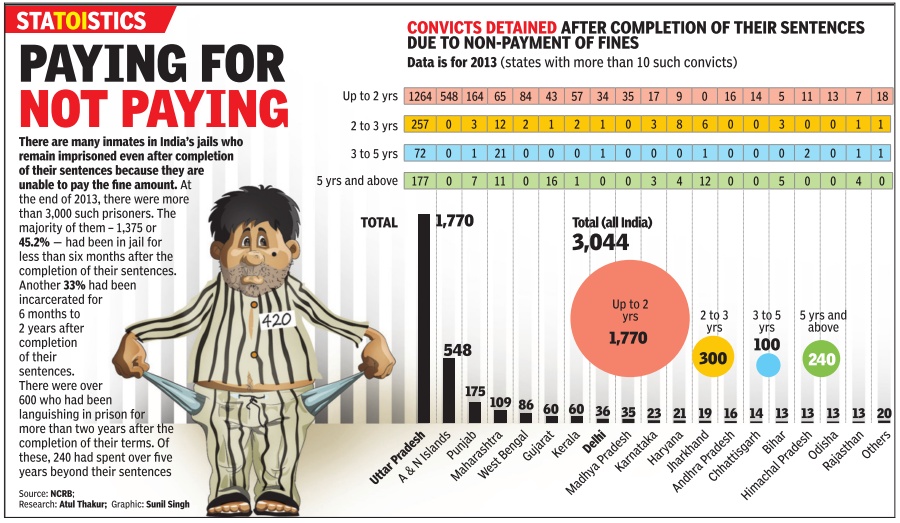
Jails in UP, MP, Chhattisgarh most crowded
Deeptiman.Tiwary @timesgroup.com New Delhi
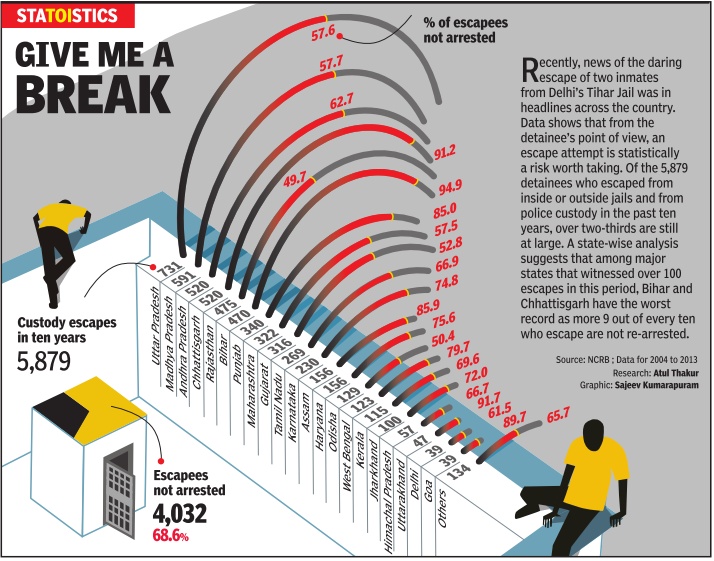
The Times of India Aug 19 2014
Overcrowding of prisons is often cited as the reason for inmates living in pitiable conditions. However, official data show prisons in almost 20 states have less number of inmates than their official capacity or are just at par.Actually a few states, including UP , MP, Chhattisgarh and Delhi, have skewed the national average with massive overcrowding their prisons.
UP alone contributes to overcrowding by close to 32,000 prisoners when cumulative overcrowding across the country stands at close to 42,000. In its 65 jails with a capacity of 47,518 inmates, UP has crammed 80,311. Chhattisgarh is another laggard state with its prisons overcrowded by 8,930 inmates against a capacity of 5,850. Delhi, whose Tihar jail has often been in the news for overcrowding, has almost twice the number of inmates against its capacity . Madhya Pradesh jails, from where six SIMI accused broke free last year, are overcrowded by over 7,000 inmates.
Curiously , Bihar is one of the best performing states along with Tamil Nadu in building optimum capacity in jails. While TN has almost 9,000 less occupancy against a capacity of 21,951, Bihar over 6,500 less inmates against its total capacity . Odisha is another state where prison capacity has improved over the years with almost 30% less occupancy against capacity
Much of these positive changes have come about in the past one decade when the Centre launched seven-year scheme worth Rs 1,800 crore for modernization of prisons. i In 2002, there were 1,135 jails t across the country with a capacity to hold 2,29,874 inmates.However, 3,22,357 inmates were t crammed in these jails. Between 2002 and 2012, number of jails increased to 1,394 with the capacity improving to 3,43,169.By the end of 2012, there were 3,85,135 inmates in these jails.
While number of inmates increased by close to 50,000 in this period, the capacity of prisons improved by over 1 lakh easing pressure on infrastructure and making life better inside jails.
Jailhouse deaths in Delhi, UP
Jailhouse deaths
By Anon, The Times of India, 12 March, 2013
India and the world: Prison population
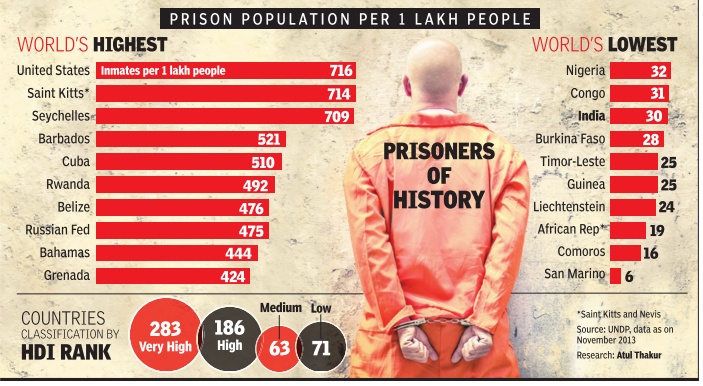
Jun 15 2015
With 716 prisoners per lakh of people, the US has the world's highest incarceration rate. Among 190 countries for which data is available, India is ranked 183rd in terms of the incarceration rate. This rate is dependent not just on the crime rate, but also on urbanization, efficiency of the criminal justice system and marginalization of some sections.Thus, there is a huge difference in incarceration rates among coloured and white people in the US. In India, Muslims, Dalits and tribals constitute 53% of the prison population -much higher than their share in the population.
“Unnatural” deaths: 2013
The Times of India, Jun 12 2015
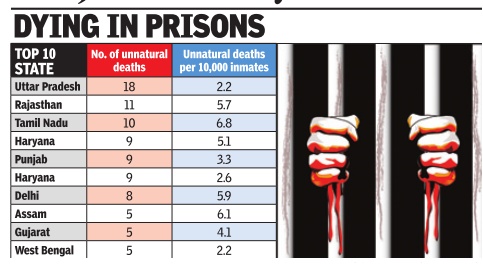
10 unnatural deaths occur in Indian jails every month
The murder of an inmate in Tihar is no isolated incident, with official data showing that there were 115 “unnatural deaths“ in India's jails in 2013, the latest year for which data is available from the National Crime Records Bureau. That's about 10 unnatural deaths every month. At 5.9 unnatural deaths per 10,000 inmates, Delhi's jails clock more than twice the national rate of 2.8 per 10,000 inmates. Whether this has anything to do with Delhi jails having over twice as many inmates as they are supposed to hold, against a national average of 118% occupancy, is a moot question.
The NCRB's prison statistics in India 2013 shows that of the 115 deaths due to unnatural causes, more than half (70) were officially classified as suicides, 12 were attributed to “assault by outside elements“ and eight to murders by inmates.With one execution and one death due to firing, the causes of deaths of 23 “others“ have not been spelt out.
The highest rates of unnatural deaths (per thousand inmates) were in Jammu & Kashmir, Tamil Nadu, Assam, Delhi and Rajasthan in that order. The lowest rates among bigger states were in undivided Andhra Pradesh, Bihar, Odisha, Maharashtra and Jharkhand. The prison statistics also show that barring Chhattisgarh, a state severely affected by Maoist insurgency , Delhi had by far the most overcrowded jails in the country . Chhattisgarh had 15,840 inmates in its jails which had a capaci ty of just 6,070, thus recording an `occupancy rate' of 261%. Delhi's 13,552 inmates were stuffed into jails meant to hold 6,250 people, an occupancy rate of 217%.The national average occupancy rate was about 118%, which shows that while jails as a rule are overcrowded in India, Delhi's prisons are almost twice as congested as the average.
CCTV surveillance
The Times of India, Jul 24, 2015
Put all prisons under CCTV camera surveillance: SC to govt
Amit Anand Choudhary
In a landmark verdict to ensure protection of human rights of prisoners, the Supreme Court on Friday directed the Centre and all state governments to put prisons under surveillance of CCTV cameras.
A bench headed by Justice TS Thakur also directed the states which have not set up Human Rights Commission to form the panel as soon as possible. There are many states and Union Territories like Himachal Pradesh, Meghalya, Nagaland, Arunachal Pradesh, Delhi, which have so far not set up the human rights watchdog panel. The court also asked the state governments to consider installing CCTV camera in police stations and lock ups to ensure that people are not subjected to unnecessary torture. It also directed that there must be two women constable in each police station.
Furlough (discretionary leave) for convicts
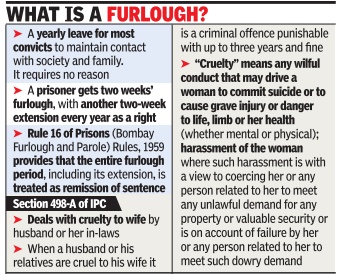
The Times of India, Sep 02 2015
Swati Deshpande
30-day parole to Dutt raises questions
Experts wonder whether jail authorities applied their mind in deciding his plea
Furlough is discretionary leave that convicts are allowed to enable re-integration with society upon their final release. It requires no specific reason. But parole is leave granted for a specific reason. It is not counted towards days served in prison, unlike furlough.
The jail manual requires a plea for parole to be processed within 45 days after it is made.The convict files and sends a parole plea to the jail superintendent, who forwards it to the divisional commissioner.The decision includes seeking a police report and communicating approval or rejection to the convict.
Delay in decision-making raises pertinent questions about whether prison authorities apply their mind, said a lawyer. Many lawyers say while the delay has come to light in Dutt's case, many applications remain pending for months, unnoticed and forgotten. “The rule book must be followed strictly as the high court has ruled in several cases,“ said advocate Farhana Shah, who has represented many convicts whose parole pleas were not decided for months. She said while Dutt's leave was “rightly granted“, though delayed, the “same consideration“ should be made for other inmates whose pleas are later rejected on the grounds that the reasons are no longer relevant. “If a parole plea is decided, for instance, after the marriage of the child of a convicted prisoner (for which leave was sought), it would defeat the very purpose,“ she said.
“If a plea is not decided in time, an extension plea would be rendered meaningless,“ said another lawyer, adding that even for furlough, the authorities are expected to verify the convict's conduct and record and only then grant leave.

